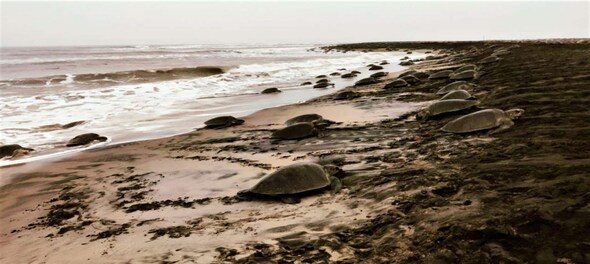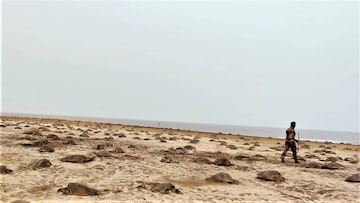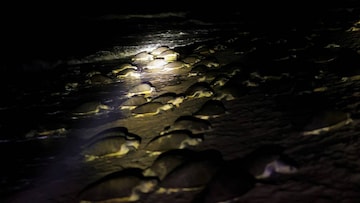
Lakhs of olive ridley turtles have begun crowding the tranquil Gahirmatha beach in Odisha, as part of their annual journey to lay eggs, presenting a rare natural phenomenon and a breathtaking sight, officials said.
The Gahirmatha beach is widely regarded as the world’s largest-known nesting ground of these reptiles. Apart from Gahirmatha, the turtles also arrive at the Rushikulya and Devi river mouths for mass nesting, they said.
Around 2.45 lakh female turtles crawled onto the seashore to dig pits with flippers on Friday, Rajnagar Mangrove (Wildlife) Divisional Forest Officer J D Pati said. "The arrival of so many turtles is a refreshing development and this is probably the largest congregation at the nesting beach in a single day," Pati said.
 Around 2.45 lakh female turtles crawled onto the seashore to dig pits with flippers on Friday. (Image: Jagyandatt Pati via Twitter)
Around 2.45 lakh female turtles crawled onto the seashore to dig pits with flippers on Friday. (Image: Jagyandatt Pati via Twitter)”We’re expecting a large congregation for the next two-three days and the mass nesting is likely to continue at least for a week,” he said. There were apprehensions that the olive ridley turtles, which derives their name from the colour of the shell, might skip their annual visit as the mass nesting was delayed by around a fortnight.
 Mass nesting of Olive Ridleys at Gahirmatha Odisha. (Image: Jagyandatt Pati via Twitter)
Mass nesting of Olive Ridleys at Gahirmatha Odisha. (Image: Jagyandatt Pati via Twitter)Last year, 3,49,694 female turtles had turned up at the nesting grounds to lay eggs from March 9 to March 23. The females virtually invade the nesting beaches, usually at the dead of the night, for laying eggs. They usually lay around 120-150 eggs and return to the sea, another official said.
Day 2 #arribada #OliveRidley #massnesting #gahirmatha #odishaDay-1 2,45,188 😁😁Day-2 1,84,994😁😁 pic.twitter.com/Wmgzn9yZdX
— Jagyandatt Pati (@jd_pati) March 27, 2022
Hatchlings usually emerge after 45-60 days. Out of every 1,000 hatchlings that enter the sea, only one manages to reach adulthood, according to official data.
Illegal egg poaching, turtle harvesting and nest destruction by humans are some of the major threats these reptiles face, apart from climate change, the officials said. The Forest Department has been prioritising the safety of the nests, with wildlife staff on round-the-clock vigil to keep predators like jackals, hyenas and wild dogs at bay, they said.
Check out our in-depth Market Coverage, Business News & get real-time Stock Market Updates on CNBC-TV18. Also, Watch our channels CNBC-TV18, CNBC Awaaz and CNBC Bajar Live on-the-go!


2024 Lok Sabha Elections | Why Kerala is in focus as the second phase begins to vote
Apr 26, 2024 9:33 AM
Bengaluru Rural Lok Sabha election: Deve Gowda's son-in-law Manjunath to lock horns with Congress' DK Suresh
Apr 26, 2024 9:11 AM

